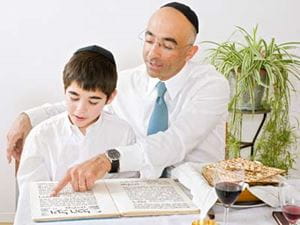
Hot on the heels of Yom Kippur, falls the next in a series of autumn Jewish holidays, Sukkot. It’s brilliant, really. After an entire month or more of soul searching, introspection, fasting, begging forgiveness, it’s time to party!
Sukkot is the autumn harvest festival—think cornucopias overflowing with pumpkins and gourds, colorful squash and Indian corn. In the Bible we’re told to celebrate for a week, dwelling in temporary booths or tabernacles (in Hebrew, called Sukkot), which is how Sukkot became known as “the Feast of Tabernacles” or “Feast of Booths” in some circles. In Jewish tradition it is called “z’mansimchateinu”—season of our joy—and it is!
Celebrating Sukkot can mean erecting a sukkah of your own, and many Jews do that. But the main ritual obligation of a Jew is to “leshevba’sukkah”—sit in the sukkah (or dwell in it). We do that to remember what it may have been like for our ancestors who while wandering the wilderness in the years between escaping Egyptian slavery and entering the promised land of Israel built temporary shelters. It’s also to recall the fall harvest in ancient times and the booths, in which the farmers slept during the harvest time. Sukkot is filled with symbols, metaphors and customs, some seemingly arcane and quaint, but which have meaning even for our time. They are worthwhile investigating even if you’re not especially observant of Jewish rituals.
Sukkah: The commandment says to sit (or dwell) in a sukkah. You could construct your own sukkah; it’s not difficult with many pre-fabs easily available online—a few interlocking pipes, tarps and lattice work and voila! Top the lattice with evergreen fronds (arbor vitae branches work well, as do palm fronds or corn stalks). Hang Indian corn, gourds, autumn garlands of tinsel and silk leaves. You can string New Year’s greeting cards and all other things decorative. If you have strands of lights and an outdoor outlet, you can have your sukkah lit nicely for the evening. Some hardy folk sleep in their sukkah. When my kids were little, they looked forward to taking their sleeping bags into the sukkah and camping out for the night. But living in the Midwest, it does tend to get chilly at night during October when the bulk of the festival usually resides, so be warned!
Hospitality: Of course, what’s the point of having a sukkah if you don’t invite friends to enjoy this season of our joy (and admire your beautifully appointed sukkah!)? It is traditional during sukkot to spread the hospitality. Hachansat orchim (welcoming guests) is an important aspect to the festival, so have a sukkah open house, or small dinner party, or just have friends and family over for a cup of coffee and cake. By inviting them to your sukkah, you can help them fulfill the commandment of sitting in the sukkah. But even if you don’t have a sukkah of your own, it’s a perfect time to practice this important value of hospitality and invite people over for a holiday (or Shabbat meal).
Lulav: The Four Species (Arba Minim): If you are in a synagogue over Sukkot, you will witness (or participate) a central ritual for the holiday—shaking of the lulav. To the inexperienced, lulav shaking seems bizarre, and a very quaint ritual practice. But the practice is rooted in deep symbolism, reminders of God’s Divine presence, and also of community.
The lulav is actually four separate pieces bound together (except for the etrog), each deep with symbolism connected to the body and community at large; there are four types of people needed to make a community or the world. Each part—each species—is crucial to make a person (or a community) whole:
- Palm frond (Lulav)—the tall, pointy palm branch is the backbone of the entire lulav. It is like the spine, giving structure and shape. Everything else in the lulav is bound together with palm leaves to make a single unit. The palm branch is a species with taste but no scent. Those who study Torah, yet do not do good deeds based upon what they’ve learned.
- Myrtle branch (Hadas)—the fragrant myrtle adds a sweet aroma to the lulav, having scent but no taste, hadas represents those who accomplish good deeds, yet have not studied Torah. The almond shape of the myrtle leaves suggests the eyes.
- Willow branch (Aravot)—willow has neither taste nor scent, representing the those with neither learning nor good deeds. Its elongated shape suggests a pair of lips.
- Etrog (citron)—the etrog, which most resembles a large, bumpy lemon has both taste (slightly bitter) and fragrance (its aroma is exquisite). Considered the heart because of its shape, it symbolizes those who have studied and accomplish good deeds.
Together, these species come together taken in hand and waved in six directions: north, south, east, west, upwards, and downwards. These directions represent where we find God—all around us. By waving the lulav at the appropriate times both in the sukkah and during Sukkot services, we are reminded that God is all around us, perhaps no closer to us than after the end of the High Holy Days and during the fall harvest season when we are so connected to nature.
Interestingly, the American Pilgrims who first came to this country so many centuries ago based their Thanksgiving on the festival of Sukkot. They found the holiday of giving thanks for the bounty of the fall harvest resonant, and the holiday stuck, as (of course) we celebrate it every November here!
Barbara Barnett is a noted Jewish educator, author, speaker, and online journalist. She has developed numerous innovative programs and initiatives, award-winning publications and worship experiences for adults and families, as well as cutting-edge educational tools.

